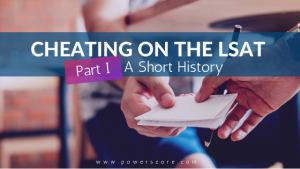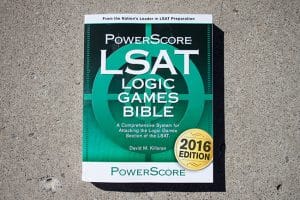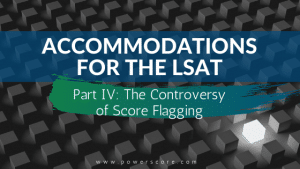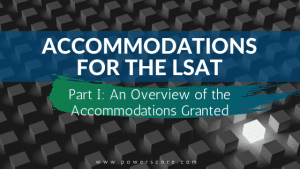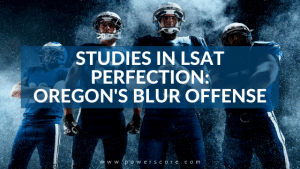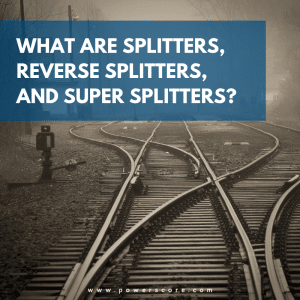For as long as there have been standardized tests, there have been attempts to cheat on those tests. The LSAT is no exception, and cheating schemes have ranged from clever to absurd. These are the two cases that received the most press coverage. The Theft of the February 1997 LSAT in Southern California In this scheme, cooked up over a five-month period, the offender stole a copy of the February 1997 LSAT from a University of Southern … [Read more...]
When Do I Diagram Conditional Reasoning Statements?
A question that frequently comes up from readers of the LSAT Logical Reasoning Bible is, when should I diagram conditional statements in the LSAT Logical Reasoning section? In the book, I talk about diagramming in a number of different chapters, but most prominently in the chapter on Conditional Reasoning.Conditional Reasoning is a Major Concept While, not surprisingly, I think that every chapter in the LR Bible has high value, the … [Read more...]
The 2015 vs. 2016 PowerScore LSAT Logic Games Bibles
Every year, we release an updated version of the LSAT Logic Games Bible, including the 2016 version. We do this to account for changes in the test, to expand and clarify certain explanations, and to add new and refreshed content in order to keep the books as useful as possible. Because of the extent of these yearly changes, one of the most common questions we get each year is: can I use an LGB from a prior year to study for this year's LSAT? … [Read more...]
Accommodations for the LSAT Part IV: The Controversy of Score Flagging
The issue of accommodated testing is a challenging one for many reasons. From the thousands of requests that the Law School Admission Council receives each year, the council must determine, on a case-by-case basis, which applicants should get accommodations, and what accommodations are appropriate. Over the past few years these issues have been getting more attention, as the council has defended a number of lawsuits based on claims about how the … [Read more...]
Accommodations for the LSAT Part III: The Facts
Now that we’ve discussed the accommodations available and the process for gaining those accommodations, let’s look at some of the facts surrounding the accommodation process. Facts reported and statements made here are based on LSAT Technical Reports, primarily this one. Let’s present the info in a series of questions and answers: Q: How many people apply for LSAT accommodations? A: Each year, several thousand people seek LSAT accommodations. … [Read more...]
Accommodations for the LSAT Part II: Applying for Accommodated Testing
In Part 1 of this series on LSAC test taking accommodations and the LSAT, we discussed various test takers who might require special accommodations for their LSAT administrations, as well as some of the kinds of test-taking accommodations granted by the LSAC. In this installment we look at the application process for special accommodations.LSAC strongly encourages you to submit all of your documentation as early as possible to ensure the … [Read more...]
Accommodations for the LSAT Part I: An Overview of the Accommodations Granted
LSAT accommodations have, in the past, been shrouded in mystery and even controversy. In brief, taking the LSAT with accommodations means that individuals with certain disabilities can take the LSAT under altered circumstances. These changed circumstances level the playing field for the applicant.So, what are these altered circumstances? It depends on the nature of the disability, but the accommodations include the following: Taking the test … [Read more...]
Conditional Diagramming Part II: “And” in the Necessary Condition
In my last post, I discussed conditional statements with "or" in the sufficient condition. Diagrams with multiple necessary conditions can, depending on the circumstances, then be used to create multiple single diagrams. Let's look at an example.If the rule reads: "If Operations is offered, then Accounting or Sales is also offered," then the diagram is solely: A O → or S Because the necessary condition is just at least … [Read more...]
Conditional Diagramming Part I: “Or” in the Sufficient Condition
Diagrams with multiple sufficient conditions can, depending on the circumstances, then be used to create multiple single diagrams. Let's look at an example.Consider a rule that reads: "If Operations or Sales is offered, then Accounting is also offered." Operations = O Sales = S Accounting = A As a single conditional statement, there are two parts to the sufficient condition (O and S), that are joined by an "or" operator. That sufficient … [Read more...]
Scholarship vs. Prestige: When to Take the Money and Run
Update! We have two podcasts around this article: Episode 5 and Episode 53 of the PowerScore LSAT PodCast. I wrote a blog titled, A Law Degree Is Worth over $1 Million. Can You Get It for Free? Predictably, we received several questions from former students who have the opportunity to attend law school on a full-ride scholarship. If you think their decision is a no-brainer, think again. Oftentimes, the choice is between attending a higher-ranked … [Read more...]
Studies in LSAT Perfection: Alinea
A few years ago I read an inspiring book called Life on the Line by Grant Achatz. Grant is the head chef at Chicago’s Alinea restaurant, which has repeatedly been named one of the best restaurants in the world. He rose through the chef ranks to head up his own kitchen, only to then battle tongue cancer that nearly took away his sense of taste permanently (he’s ok now, fortunately). I liked the book so much that I made a trip up to Alinea last … [Read more...]
Studies in LSAT Perfection: Oregon’s Blur Offense
For a while now, I’ve been meaning to write a series of articles on how the pursuit of perfection in various fields can teach valuable lessons for LSAT preparation, and how that pursuit sometimes conflicts with prevailing conventional wisdom. In honor of tonight’s national championship football game, we start with Oregon’s Blur Offense. The Blur Offense If you’re not familiar with football or are just a casual fan, you may not be aware that … [Read more...]
What Are Splitters, Reverse Splitters, and Super Splitters?
If you are applying to law school, you will come across an unusual and somewhat confusing term: Splitter. And no, it has nothing to do with baseball pitches, cutting trees, or a certain San Antonio Spurs/Philadelphia 76ers basketball player. A "splitter" is someone who has LSAT and GPA numbers that are split between high and low marks. Often, the medians for a law school play a role in determining if one is truly a splitter. While this concept is … [Read more...]
The Rise and Fall of Double-Question LSAT Logical Reasoning Stimuli
I've talked before (notably here and here) about how the content of LSATs changes from test to test. But, there are even changes in the type of question forms you see. For example, in the early 1990s, Justify the Conclusion questions were rather rare, whereas in the 2000s they appeared relatively frequently. In Logic Games, Rule Substitution questions did not start appearing until June 2009. In Logical Reasoning, one question format that used to … [Read more...]

